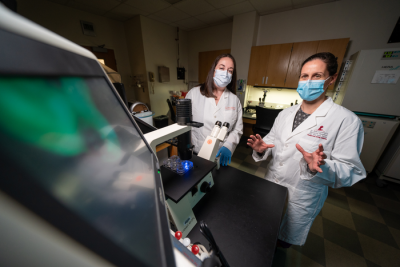
From left: First author Jackie Norrie, Ph.D., St. Jude Department of Developmental Neurobiology, and co-corresponding author Rachel Brennan, M.D., St. Jude Department of Oncology, created retinoblastoma models that more closely mimics the biology of patient tumors. Image credit: St. Jude Children's Research Hospital
Scientists at St. Jude Children’s Research Hospital have created a laboratory model for studying retinoblastoma driven by inherited mutations in the RB1 gene. Retinoblastoma is a rare cancer of the retina, the thin tissue inside the back of the eye. The researchers created retinoblastoma organoid models that closely mimic the biology of tumors in patients. These models provide an important resource for studying the earliest stages of the disease as well as screening new therapies. The findings were published recently in Nature Communications.
Retinoblastoma occurs in very young children, and in some cases children are born with the disease. Inherited mutations in RB1 are one reason why this happens, but how these tumors form and what other factors underlie their development remains difficult to study.
“What we have developed with these retinoblastoma organoids is, for the first time ever, a laboratory model where it’s possible to study the processes that go on when retinoblastoma is starting to form,” said co-corresponding author Michael Dyer, Ph.D., St. Jude Department of Developmental Neurobiology chair. “We can follow the process from the beginning to the early stages of tumor development, which is really exciting and opens up new avenues for research.”